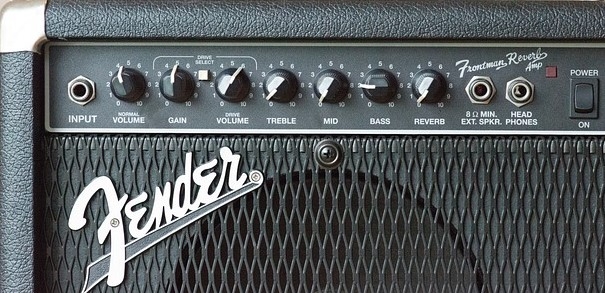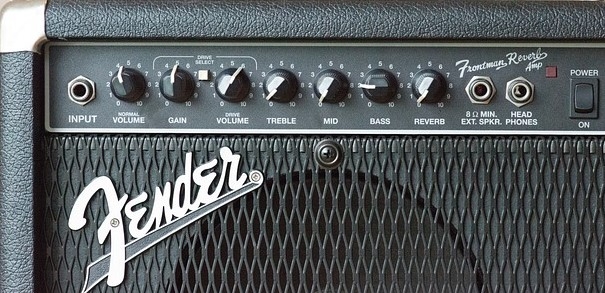To be skillful at using a Fender amp, you need to master the settings and controls. Fender has several amps and it is important that you understand them well. In this guide, I have provided general guidelines on Fender amp settings giving details of how Fender amps works, key controls and listing some examples of amp setting.
Let’s get started.
What are Fender Amp Settings?
The term ‘Fender Amp settings’ simply refers to the various combinations of volume, tone and other controls on a Fender amplifier. Every Fender amp has these key controls which when set at different values create different sounds.
Having used two models of Fender amps, the ‘ mustang v.2 ‘ and the ‘ deluxe reverb reissue,’ I can confidently say that there are many settings that you can create on a Fender amp.
How do Fender Amps Work?

Fender amps work by taking an input signal (usually from a guitar) and amplifying it. This is done using a combination of vacuum tubes, capacitors, resistors and transformers.
The signal enters the amp through the input jacks and passes through a grid resistor (R1). This resistor limits the amount of current that can flow into the grids of the first preamp tube (V1).
The signal then passes through the cathode capacitor (C3) and into the grid of the first preamp tube (V1). The cathode resistor (R4) limits the amount of current that can flow through the tube.
The signal then passes to the anode of the tube where it is amplified. The amplified signal then passes through the plate resistor (R6) and into the grid of the second preamp tube (V2).
This process is repeated in the second preamp tube (V2) and the signal is further amplified. The signal then passes to the phase inverter where it is inverted and sent to the power tubes.
The power tubes amplify the signal and send it to the output transformer where it is transformed into the correct impedance for the speaker. The speaker then converts the electrical signal into sound waves.
Fender Amp Settings:
Most Fender amps have two channels with volume controls and 5 main settings which enable you to control the bass, level of distortion, tone, and built-in reverb setting. The tone is controlled by middle and treble control that you can find on the amplifier. The reverb is produced by a spring in the amplifier and this is one of the most defining factor of Fender amps. You can control the amount of reverb with a knob on the amplifier.
Some models also have a “bright switch” which adds highs to your sound, making it “brighter.” This can be useful for cutting through a mix when playing with a band.
The volume controls on each channel will be different depending on the model of the amplifier. For example, the Mustang V2 has a “Gain” control which adjusts the amount of distortion on the clean channel, and a “Volume” control which adjusts the overall level of the sound.
The “Bass” and “Treble” controls adjust the low and high frequencies respectively. The “Middle” control adjusts the midrange frequencies. These three controls work together to create the overall tone of the amplifier.
The “Presence” control on some models (such as the Deluxe Reverb) adjusts the highs, making the sound “sharper.” The “Reverb” control adjusts the amount of reverb.
Fender Amp Settings: Key Controls
Now that we have a basic understanding of how Fender amps work, let’s take a look at the key controls and how they affect the sound.
Volume: The volume control adjusts the level of the signal going to the power amplifier. This in turn affects the amount of distortion and overall volume of the sound.
Gain: The gain control adjusts the amount of preamp distortion. This can be used to create a wide range of sounds from clean to heavily distorted. Turning the gain setting up in your Fender amp will distort the tone further which may be suitable for genres such as Metal. Gain setting of low to mid-level is suitable for most genres such as Rock, Pop, Indie, and so on.
Bass: The bass control adjusts the low frequencies. Turning the bass up will make the sound “ warmer” and fuller. I don’t suggest turning the bass setting up as it will make the sound “muddy”.
Middle: The middle control adjusts the midrange frequencies. Turning the middle up will make the sound more “ cutting” and “ aggressive”. Low seeting is generally suitable for most genres.
Treble: The treble control adjusts the high frequencies. Turning the treble up will make the sound brighter and “shinier”. I don’t suggest turning the treble all the way up as it will make the sound too “harsh”.
Reverb: The reverb control adjusts the amount of reverberation (echo) in the sound. This can be used to create a wide range of sounds from clean to heavily distorted. Turning the reverb setting up in your Fender amp will create a “wet” sound with more echo. Reverb setting of low to mid-level is suitable for most genres such as Rock, Pop, Indie, and so on.
Presence: The presence control adjusts the highs, making the sound “sharper”. This can be useful for cutting through a mix when playing with a band.
Fender Amp Settings: Basic Setups
Now that we know the key controls, let’s take a look at some basic setups. These are only meant to be starting points. Experiment with the controls to find the sound you’re looking for.
Clean: For a clean sound, set the volume, gain, and reverb controls to low or off. Set the bass, middle, treble, and presence controls to your taste.
Overdrive: For an overdriven sound, set the volume control to around 3 or 4. Set the gain control to around 6 or 7. Set the bass, middle, treble, and presence controls to your taste.
Distortion: For a distortion sound, set the volume control to around 5 or 6. Set the gain control to around 8 or 9. Set the bass, middle, treble, and presence controls to your taste.
Fender Amp Settings: Tips
Here are some general tips for getting the most out of your Fender amp:
-Start with the volume and gain controls at low settings and gradually increase them until you find the sound you’re looking for.
– experiment with the EQ controls to find the sound you’re looking for.
-If you’re using an overdrive or distortion pedal, set the amp’s gain control to low and use the pedal to control the amount of distortion.
-If you’re playing with a band, try turning up the presence control to help your sound cut through the mix.
Fender Amp Settings for Rock

- Gain: 6 – This will give you a nice crunchy sound without being too over the top.
- Bass: 4 – This will give you a full sound without making the amp sound muddy.
- Middle: 5 – This will give your sound some midrange bite.
- Treble: 6 or 7 – This will give you a bright sound that cuts through the mix.
- Reverb: 2 or 3 – This will add a bit of ambience to your sound without making it too wet.
- Presence: 5 – This will help your sound cut through the mix.
Fender Amp Settings for Metal

- Gain: 8 or 9 – This will give you a heavy distortion sound.
- Bass: 5 ti 7 – This will give you a full sound without making the amp sound muddy.
- Middle: 4 or 5 – This will give your sound some midrange bite.
- Treble: 6 or 7 – This will give you a bright sound that cuts through the mix.
- Reverb: 3 – This will add a bit of ambience to your sound without making it too wet.
- Presence: 7 – This will help your sound cut through the mix.
Fender Amp Settings for Blues

- Gain: 3 or 4 – This will give you a nice overdriven sound.
- Bass: 4 or 5 – This will give you a full sound.
- Middle: 5 to 7 – This will give your sound a warm midrange tone.
- Treble: 5 or 6 – This will give you a bright sound that cuts through the mix.
- Reverb: 2 or 3 – This will add a bit of ambience to your sound without making it too wet.
- Presence: 4 – This will help your sound cut through the mix.
Fender Amp Settings for Jazz
- Gain: 1 or 2 – This will give you a clean sound.
- Bass: 4 – This will give you a full sound.
- Middle: 3 – This will give your sound a warm midrange tone.
- Treble: 5 – This will give you a
- bright sound.
- Reverb: 2 – This will add a bit of ambience to your sound without making it too wet.
- Presence: 3 – This will help your sound cut through the mix.
Fender Amp Settings for Country

- Gain: 2 or 4 – This will give you a nice overdriven sound.
- Bass: 3 to 5 – This will give you a full sound.
- Middle: 4 or 5 – This will give your sound a warm midrange tone.
- Treble: 6 to 8 – This will give you a bright sound that cuts through the mix.
- Reverb: 2 – This will add a bit of ambience to your sound without making it too wet.
- Presence: 5 – This will help your sound cut through the mix.
These are just a few examples of the many different sounds you can get with a Fender amplifier. Experiment with the controls to find the sound that’s right for you. And don’t be afraid to ask your fellow guitarists for their settings – they may have some great ideas that you haven’t thought of yet.
FAQs
Q: What is the best Fender amp for rock?
A: The best Fender amp for rock is the Fender Twin Reverb. It’s a classic amp that has been used by some of the biggest names in rock, including Jimi Hendrix, Eric Clapton, and Stevie Ray Vaughan.
Q: What is the best Fender amp for metal?
A: The best Fender amp for metal is the Fender Hot Rod DeVille. It’s a powerful amp that can handle high gain settings without sounding muddy.
Hi there! I am Jack Musau, the founder of this Best Guitar Amp Review site. I am an avid musician with several years using both traditional and electric guitars and created this site to assist others looking to find the best guitar amplifiers in the market today. I also offer private coaching and training on how to use guitars and guitars amps of all kinds. You can reach out to me using my email, jack@soundspros.com.

